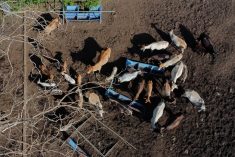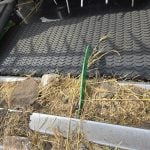Pulse growers can maintain the value of their crop by checking it during storage.
“Because pulse crops have large seeds, it takes some time for the moisture within the seed to equalize throughout,” said Ray McVicar, a special crops specialist with Saskatchewan Agriculture.
“The process is known as ‘going through a sweat.’ ”
He said this is likely to happen if crops are harvested at high temperatures.
“The key to avoiding mould and other storage problems is the use of aeration to cool and dry the seed. Testing with a moisture meter should be done a number of times after the crop is binned. Moisture conversion charts for use with moisture meters are available for pulse crops, including chickpeas.”
Read Also

China’s grain imports have slumped big-time
China purchased just over 20 million tonnes of wheat, corn, barley and sorghum last year, that is well below the 60 million tonnes purchased in 2021-22.
As fall weather turns colder, air and grain temperatures drop quicker next to the walls of the bins than they do at the centre of the bin. This starts air moving down the wall and up through the centre of the warmer grain, where it picks up moisture.
Condensation occurs when this moist air reaches the top of the bin. In the spring, the problem is reversed and condensation occurs at the bottom.
“This moisture migration due to natural convection within the bin can be prevented by using an aeration fan to cool the grain in the fall and warm it in the spring.”
For safe storage, McVicar said pulse crops should be cooled to less than 15 C and dried to less than 14 percent moisture. University of Saskatchewan research has found that warm pulse grain that is cooled within 24 hours of being placed in the bin is more stable, even if the moisture content is low. Seed that is cooled to 10 C will store for long periods, he said.
An aerated bin can provide both cooling and drying. Cooling may be accomplished in one day, but drying may take three to four weeks. Aeration fans must have adequate power to provide air flow through the grain.
Resistance to this airflow depends on seed size and the amount of fines, chaff and other foreign material like green weed seeds. The recommended air needed for drying pulse crops with aeration is one to two cubic feet of air per minute per bushel.
Another factor when determining the required airflow in an aeration bin is the type of floor. Fully perforated floors provide more uniform air distribution than a hopper bottom design.
“Because pulse crops have a large seed compared to cereals, they provide a lower resistance to airflow and greater ease in drying,” McVicar said.
“But fines, chaff and green weed seeds can greatly reduce airflow and cause air movement to be channeled around wet spots.”
To improve air flow, pulse crops with a large amount of foreign material should be cleaned before they are stored, he said.
Drying pulse crops by no more than four to five percent moisture points in one pass can reduce seed injury caused by extreme heat and cold.
“The grain should also be allowed to temper for about eight hours between passes. For chickpea, bean and other large pulse crops, the tempering time should be increased to 24 hours.”
Pulse-handling equipment like conveyors, bean ladders and hopper-bottom bins can reduce mechanical injury, but require proper handling.
Hopper-bottom bins and bins with installed bean ladders can dent or collapse due to off-centre or non-symmetric unloading. Improper unloading gates, grain crusting and spoilage can cause this, or non-uniform flow caused by obstructions like improperly installed bean ladders.
“So it’s always a good idea to monitor bins for crusting and spoilage and, by watching, to ensure the grain empties smoothly and uniformly,” McVicar said.
“Reinforcement to the bin wall, especially at the joint between the hopper and the bin, can help prevent structural damage.”














